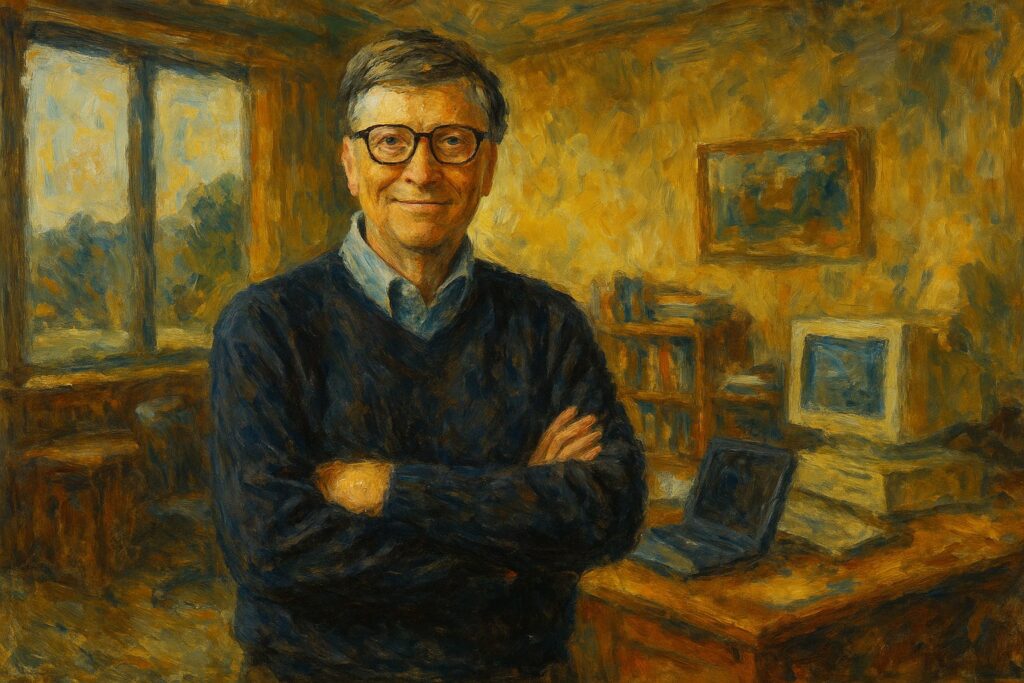
Bill Gates Profile
Bill Gates
TL;DR
Co-founder of Microsoft, Bill Gates built the software foundation of the personal computing era. He left full-time work at Microsoft to lead a $67B philanthropic effort targeting global health, education, and climate innovation.
Career Highlights
Gates co-founded Microsoft in 1975 with Paul Allen, licensing MS-DOS to IBM and later launching Windows, which became the dominant operating system globally. The company went public in 1986 and became a $3T enterprise by 2024.
In 2000, Gates stepped down as CEO and transitioned to philanthropy through the Bill & Melinda Gates Foundation. By 2008, he left day-to-day operations entirely. He has since focused on vaccine infrastructure, education reform, sanitation systems, and more recently, climate tech.
Gates returned briefly in a board role in 2020 but left amid scrutiny surrounding personal conduct and ties to Jeffrey Epstein. He continues to publish annual “Goalkeepers” reports and invest in frontier science and energy ventures.
I. The Inflection Point
The DOJ’s antitrust lawsuit in the late ’90s was the first public reckoning for Microsoft and Gates. After being portrayed as a ruthless monopolist in court and press, Gates gradually stepped back, ceding CEO responsibilities to Steve Ballmer.
This moment was more than legal—it marked his shift from aggressive capitalist to technocratic problem-solver. His foundation became his new operating system.
II. The Build
Gates turned software into a licensing empire.
- MS-DOS was licensed to IBM and became the Trojan horse for Microsoft’s rise.
- Windows dominated the GUI era by bundling products like Internet Explorer and Office.
- Microsoft Office became the most successful software suite in history.
- Bill & Melinda Gates Foundation now funds global health solutions at nation-state scale, driving vaccine access, agricultural reform, and pandemic response.
His method: codify the system, then scale it. Whether with code or charity, Gates optimized for global impact.
III. The Person
A cerebral strategist with a competitive streak, Gates is famous for his “think weeks,” obsession with data, and clipped conversational style. He reads over 50 books per year and writes long memos, even to this day.
In meetings, he could be cutting and impatient. “That’s the stupidest thing I’ve ever heard” was a common refrain at Microsoft. Yet many who worked with him describe a relentless desire to get to the truth, not to win arguments.
Now more mellow, Gates continues to advocate for evidence-based policies while making big bets on risky climate tech.
IV. The Network & Numbers
Milestones Box
- Microsoft IPO: 1986
- Current Valuation: ~$3T
- Foundation Endowment: $67B+
- Employees (Microsoft): 220,000+
Key Relationships
- Warren Buffett: Major foundation donor and close friend
- Paul Allen: Co-founder, early technical counterpart
- Melinda French Gates: Co-founder of the foundation, post-divorce maintains independent philanthropic initiatives
- Steve Ballmer: Succeeded Gates as CEO in 2000
V. The Thesis
Gates believes global problems require measurable, scalable solutions. His philanthropy doesn’t run on sentiment—it runs on spreadsheets, KPIs, and milestone charts. He views progress like a product roadmap.
“If you can’t measure it, you can’t fix it,” he said. His focus now: eradicating disease, mitigating climate collapse, and bringing rational optimism back into fashion.
Factbox
| Name | Bill Gates |
|---|---|
| Age | 68 |
| Location | Medina, WA |
| Company & Role | Microsoft (Co-founder), Gates Foundation (Co-chair) |
| Funding | IPO (1986), Foundation: $67B+ |
| Most Recent Round | N/A (public) |
| Employees | 220,000+ (Microsoft) |
| Contrarian Belief | Philanthropy should be managed like a business |






